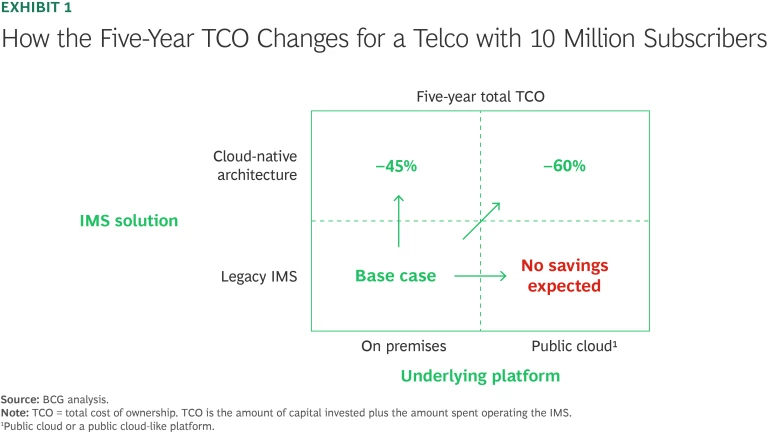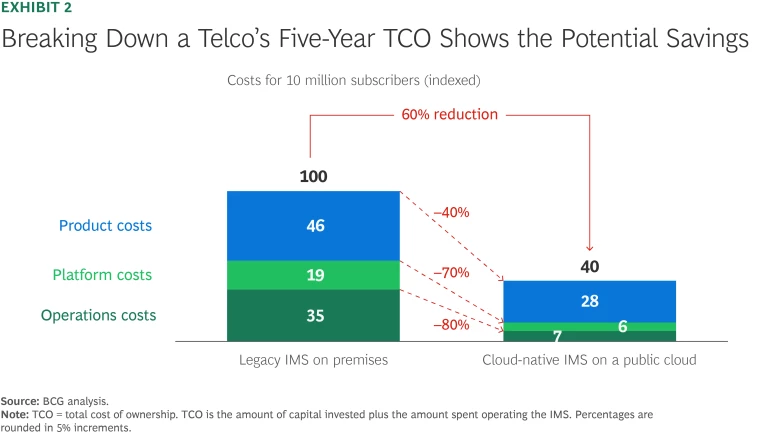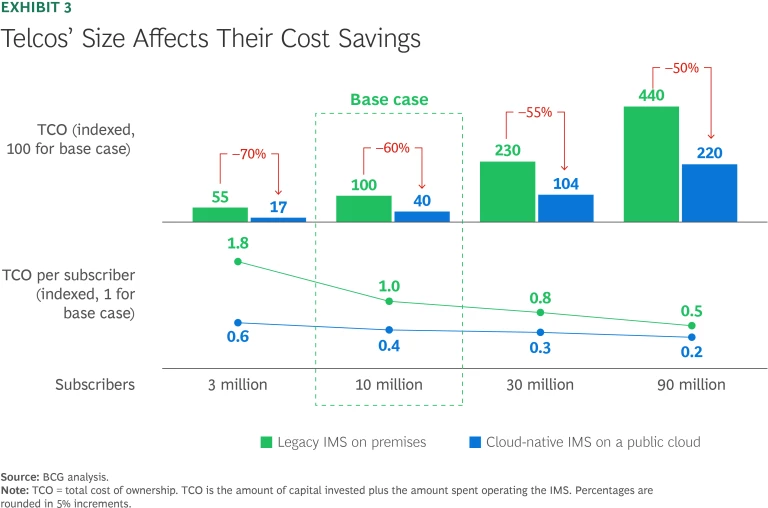Most telcos are fully convinced that they must transition to a cloud-native architecture to gain more agility and scalability and to launch new services in a cost-effective manner. The question is not whether to move but where to start. Most mobile network operators see a full-blown cloud transformation of the network as a challenging, time-consuming undertaking. It is complex and difficult to fund, and it involves planning and integration with several vendors.
To accelerate the transformation and yield benefits earlier in the journey, telcos should transform one network function at a time. One of the most attractive functions to tackle first is the Internet Protocol Multimedia Subsystem (IMS).
The Case for Migrating the IMS
The IMS is a good candidate for migration because moving it to a cloud-native architecture can help telcos navigate competing priorities, including costs, stability, scalability, and
Costs. Costs continue to rise for telcos, and margins are under pressure. Meanwhile, recent investments in 5G are not yet paying off, and operators still face years of maintenance on previous network generations. In this environment, bringing down costs or making them more flexible is essential.
The IMS is key to providing voice services, which operators will have to offer for the foreseeable future. Consumers consider reliable voice services critical, and most regulators require that telcos offer native voice, emergency calling, and fixed-line compatibility. However, telcos are unlikely to see a significant increase in revenue from voice services, and the IMS is a significant cost item (typically responsible for 10% to 15% of the total cost base of the mobile and fixed core infrastructure). By migrating their IMS to a cloud-native architecture, telcos can make the cost of the IMS more flexible.
Stability and Scalability. Most operators have made few changes to their IMS in recent years and, hence, carry the burden of appliance-based platforms. This means that many will have to refresh their IMS over the next few years, and they are concerned about even minor outages on mission-critical services during the transition. But mature and battle-tested cloud-native IMS solutions are available. These offerings are also agnostic when it comes to platform and cloud providers, easing the worry that today’s lock-in to a telecom equipment vendor will become tomorrow’s lock-in to a cloud provider.
Because the IMS is not overly sensitive to latency, it is also possible for operators to optimize deployments using public cloud infrastructure facilities that are at a distance. This leeway on latency also opens up the potential to build cloud-native roaming gateways. Such gateways improve the speed and responsiveness of roaming services because they don’t route roaming traffic back to the home operator’s network.
- Innovation. A cloud-native IMS better supports innovation (for instance, in the Internet of Things domain), as it’s easier to integrate into end-to-end service orchestration and network-as-a-service platforms via microservices. Therefore, operators that migrate their IMS to a cloud-native architecture on a public cloud can develop and offer new services faster and more easily.
We analyzed the migration options for an operator with a legacy on-premises IMS by assessing the experience of operators that have made the change. We identified two dimensions: moving an IMS to a public cloud (or public cloud-like platform) and moving it to a cloud-native architecture.
Our analysis showed the total cost of ownership (TCO) over five years for an operator with 10 million subscribers falls the most—by 60%—when a telco migrates its IMS to a cloud-native architecture and deploys it on a public cloud or a public cloud-like platform. (See Exhibit 1.) We also extended this analysis to operators with 3, 30, and 90 million subscribers, and this was always the most cost-effective option.

Why the Costs Fall
To understand the potential savings that telcos can capture by migrating their IMS to a cloud-native architecture on a public cloud, we took an in-depth look at three main cost categories for an operator with 10 million subscribers. (See Exhibit 2.)

Product Costs. This category includes license fees for the IMS solution, the cost of maintenance and support, and the cost of software updates and upgrades. For a legacy IMS solution deployed on premises, the product costs are the most significant and can decline by 40% when an operator migrates to a cloud-native IMS solution deployed on a public cloud. Solution vendors that use containerized microservices have lower development and maintenance costs and, therefore, can charge less. (Our analysis assumes that the operator has licenses for its legacy IMS and doesn’t need to replace or renew them, and it assumes that new licenses will be needed for a new IMS solution.)
Platform Costs. This category includes the cost of server instances based on the number of virtual CPUs and the amount of RAM that are required per user plus data transfer costs. It is the smallest of the three cost categories, but it shows a cost reduction of 70% for two reasons. First, cloud-native solutions inherently make more efficient use of computational capacity because they use microservices. Second, resources are easier to scale as needed. Operators can use resources from the public cloud provider, rather than procure and maintain on-premises capacity that is sized for peak usage.
Operations Costs. This category has the highest savings potential: 80%. To operate, monitor, and troubleshoot a cloud-native IMS deployed on a public cloud, an operator needs significantly fewer resources because it benefits from modern software development practices and capabilities, such as continuous integration and continuous delivery (CI/CD), self-healing functionality, automation, and AI-powered operations. In addition, updates and upgrades of the IMS solution are significantly easier to perform. This category also includes the cost of migration, as well as the required upskilling of the team and the procurement and introduction of new tools. However, providers typically include training and certification as part of the infrastructure package, which can further reduce a telco’s costs.
In contrast, doing a lift and shift of a legacy IMS to a public cloud and running it on a virtual machine will likely not decrease an operator’s overall cost for two reasons. First, this type of migration requires more compute resources and increases complexity during the IMS life cycle management. Second, it prevents smooth on-demand scaling, which is an important driver of cost reduction for a cloud-native IMS solution.
The migration to a cloud-native IMS deployed on premises yields a more modest 45% reduction in TCO. When comparing this scenario with a deployment on a public cloud, operations costs remain higher due to less improvement in remote monitoring and automation. There is also a slightly less efficient usage of resources.
Subscribe to receive the latest insights on Technology, Media, and Telecommunications.
How Do the Costs Scale?
Our analysis shows that migrating to a cloud-native IMS on a public cloud can reduce the TCO per subscriber in excess of 50% for large operators (30 million and 90 million subscribers) that can spread their fixed costs across a large base. (See Exhibit 3.)

To understand these differences, it’s helpful to look at the drivers behind the three main cost categories.
In our experience, the product costs per subscriber are similar for telcos with 3 million, 10 million, and 30 million subscribers. Operators with more subscribers typically can reduce their product costs per subscriber by an additional 50%.
Platform costs are proportional to the number of subscribers for all operators since typically they benefit equally from the efficiency and scalability of a cloud-native solution. However, larger operators may be able to negotiate lower prices for cloud-based deployments.
Operations costs typically have only a weak correlation with the number of subscribers. Migration costs, which are part of this category, are similar for all operators, from small to large. Because these costs are largely fixed, they help drive down the per subscriber costs for larger operators.
A Step Toward Transformation
In financial terms, the message is clear: there is a compelling case for migrating a legacy IMS to a cloud-native IMS and deploying it on a public cloud. For telcos monitoring free operating cash flow, there is the additional benefit of moving spending from a capital to an operating expenditure.
But, beyond decreasing costs and making them more elastic, there is a very substantial—and in the long term, maybe even more important—benefit to undertaking a migration: it can give an organization the opportunity to see a network function efficiently operate on a public cloud and be a step toward a broader transformation. In addition, a migration can provide valuable lessons and enhance people’s skills, tool sets, processes, and organizational setups, readying a telco to take the next step. Some of the most relevant outcomes include:
- Operating a complete CI/CD pipeline and a modern DevOps application management model, fully integrated with vendors, that improves efficiency, reduces risk, and speeds up product delivery
- Leveraging automation, including automated testing and log analysis
- Deploying cloud and hyperscaler technologies for operations and driving the adoption of individual modules (such as AI and machine learning) throughout the organization
- Building software using agile processes that have the flexibility to adapt more quickly as business requirements change
- Changing the operating model from established plan-build-run cycles to a more agile approach with continuous improvements
Insights from such a brownfield transformation of a network function can then readily be applied to other functions, such as the packet core, and naturally complement ongoing initiatives, such as the greenfield deployment of a 5G core on a public cloud. As more and more network functions become available as cloud-native software, such experiences and resulting capabilities will become increasingly essential for migration.
Telcos that are wondering how to start migrating to cloud-native network functions deployed on a public cloud have compelling reasons for selecting the IMS. The financial benefits are clear for a wide variety of operators. The organizational benefits, though harder to quantify, are no less valuable. Embarking on an IMS migration will accelerate telcos’ transformation journey toward running a best-in-class, software-based, resilient, and future-proof network.
This research was the collaboration of BCG, Amazon Web Services, and ng-voice.






